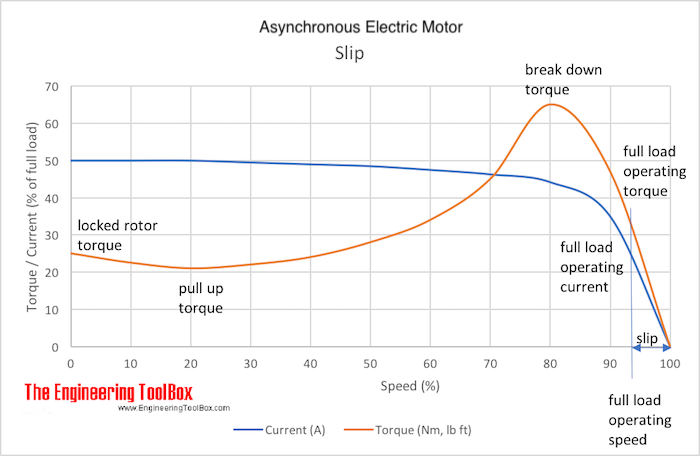Electrical Induction Motors - Torque vs. Speed
Full load operating torque vs. break down, pull up and locked rotor torque.
Torque is the turning force through a radius - with the units Nm in the SI-system and the units lb ft in the imperial system.
The torque developed by an asynchronous induction motor varies when the motor accelerates from zero to maximum operating speed.

Locked Rotor or Starting Torque
The Locked Rotor Torque or Starting Torque is the torque an electrical motor develops when starting at zero speed.
A high Starting Torque is more important for application or machines hard to start - like positive displacement pumps, cranes etc. A lower Starting Torque can be accepted for centrifugal fans or pumps where the start load is low or close to zero.
Pull-up Torque
The Pull-up Torque is the minimum torque developed by an electrical motor when it runs from zero to full-load speed (before it reaches the break-down torque point).
When a motor starts and begins to accelerate the torque in general will decrease until it reach a low point at a certain speed - the pull-up torque - before the torque increases until it reach the highest torque at a higher speed - the break-down torque - point.
The pull-up torque may be critical for applications that needs power to go through some temporary barriers achieving working conditions.
Break-down Torque
The Break-down Torque is the highest torque available before the torque decreases when the machine continues to accelerate to working conditions.
Full-load (Rated) Torque or Braking Torque
The Full-load Torque is the torque required to produce the rated power of an electrical motor at full-load speed.
In imperial units the Full-load Torque can be expressed as
T = 5252 Php / nr (1)
where
T = full load torque (lb ft)
Php = rated horsepower
nr = rated rotational speed (rev/min, rpm)
In metric units the rated torque can be expressed as
T = 9550 PkW / nr (2)
where
T = rated torque (Nm)
PkW = rated power (kW)
nr = rated rotational speed (rpm)
Example - Electrical Motor and Braking Torque
The torque of a 60 hp motor rotating at 1725 rpm can be calculated as:
Tfl = 5252 (60 hp) / (1725 rpm)
= 182.7 lb ft
NEMA Design
NEMA (National Electrical Manufacturers Association) have classified electrical motors in four different designs where torques and starting-load inertia are important criteria.
Accelerating Torque
Accelerating Torque = Available Motor Torque - Load Torque
Reduced Voltage Soft Starters
Reduced Voltage Soft Starters are used to limit the start current reducing the Locked Rotor Torque or Starting Torque and are common in applications which is hard to start or must be handled with care - like positive displacement pumps, cranes, elevators and similar.



